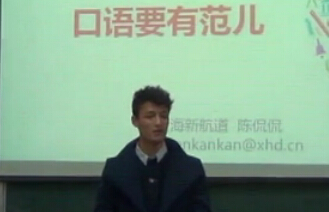雅思阅读材料之亚洲的孩子为什么大多戴眼镜?
2013-09-26 12:41 供稿单位: 新航道
出国英语考试有哪些 雅思6.5是什么水平 雅思阅读评分标准 托福阅读评分标准 雅思和托福的区别
Up to 90% of school leavers in major Asian cities are suffering from myopia - short-sightedness - a study suggests. Researchers say the "extraordinary rise" in the problem is being caused by students working very hard in school and missing out on outdoor light.
近期的一项研究表明,在亚洲主要城市中,高达90%的毕业生都患有近视。 研究人员说,这一问题“陡然增加”的原因是学生在学校拼命学习,较少接触户外光线。
The scientists told the Lancet that up to one in five of these students could experience severe visual impairment and even blindness. In the UK, the average level of myopia is between 20% and 30%.
研究者对权威医学期刊《柳叶刀》杂志表示,五个学生中有一个可能会遇到严重的视力障碍,甚至失明。在英国,平均近视率是20%到30%。
According to Professor Ian Morgan, who led this study and is from the Australian National University, 20-30% was once the average among people in South East Asia as well. "What we've done is written a review of all the evidence which suggests that something extraordinary has happened in east Asia in the last two generations," he told BBC News.
领导这项研究的是来自澳大利亚国立大学的伊恩·摩根教授。他表示东南亚地区的平均近视率之前也是在20-30%之间。“我们所做的就是将所有研究结果落实书面形式,证据表明,在东亚地区最近两代人中出现的近视率飙升非同寻常,”他告诉BBC记者说。
"They've gone from something like 20% myopia in the population to well over 80%, heading for 90% in young adults, and as they get adult it will just spread through the population. It certainly poses a major health problem."
“东南亚地区的近视人口已经从大约20%激增至超过80%,青壮年近视率正在接近90%,随着他们变为成年人,这将影响到整个人口结构。这必然会诱发重大的健康问题。”
Eye experts say that you are myopic if your vision is blurred beyond 2m (6.6ft). It is often caused by an elongation of the eyeball that happens when people are young. According to the research, the problem is being caused by a combination of factors - a commitment to education and lack of outdoor light.
根据眼科导师的说法,如果你的视力超过2米(6.6英尺)就模糊不清,那你就是近视。其原因通常是由于人们年轻时眼球拉伸造成的。据研究,这个问题是由多种因素造成,包括专注学习以及较少接触室外光线。
Professor Morgan argues that many children in South East Asia spend long hours studying at school and doing their homework. This in itself puts pressure on the eyes, but exposure to between two and three hours of daylight acts as a counterbalance and helps maintain healthy eyes.
摩根教授认为,东南亚地区的许多儿童花大量时间在校学习和做功课。这本身就对眼睛造成压力,但接触两三个小时的日光可起到抗衡作用,并有助于保持健康的眼睛。
"We're talking about the need for two to three hours a day of outdoor light - it doesn't have to be massively sunny, we think the operating range is 10-20,000 lux, we're not sure about that - but that's perfectly achievable on a cloudy day in the UK."
“我们所说的是中需要两到三个小时的户外光线,并不需要大量的光线。我们认为1到2万的勒克斯照明强度就可以,对此我们不能确定,但在英国即使阴天也是完全可以做到的。”
Massive pressures
巨大压力
Cultural factors also seem to play a part. Across many parts of South East Asia, children often have a lunchtime nap. According to Professor Morgan they are missing out on prime light to prevent myopia.
文化因素似乎也起着一定作用。在东南亚的许多地区,儿童往往有午间小睡的习惯。据摩根教授说,他们错过了预防近视的黄金光线。
"Children suffer from a double whammy in South East Asia," says Professor Morgan. "As a result of massive educational pressures and the construction of a child's day, the amount of time they spend outside in bright light is minimised."
摩根教授说:“东南亚孩子是祸不单行”。“由于巨大教育压力和孩子活动方式不合理,他们在室外享受明亮光线的时间少之又少。”
A big concern is the numbers of students suffering from "high" myopia. According to Professor Morgan, this affects between 10% and 20% of students in Asian cities. It can lead to vision loss, visual impairment and even blindness.
患高度近视的学生人数增多是一个大问题。据摩根教授所说,在许多亚洲城市中有10%到20%的学生受此影响。其结果可能是视力下降、视力障碍,甚至失明。
"These people are at considerable risk - sometimes people are not told about it and are just given more powerful glasses - they need to be warned about the risk and given some self-testing measures so they can get to an ophthalmologist and get some help."
“这些人都面临相当大的风险,有时人们对此并不了解,而只换戴更大度数的眼镜。需要有导师警告他们注意其中相关的风险,并指导他们进行一些自我检测,这样他们就能够去看眼科医生并得到一些帮助。”
For decades, researchers believed there was a strong genetic component to the condition. It was believed that people from China, Japan, Korea and other countries were particularly susceptible to developing myopia. But this study strongly suggests an alternative view.
几十年来研究人员一直认为,近视具有很强的遗传成分。据信中国、日本、韩国等国家的人特别容易发展成近视。但这次研究却有力地证明了另一种观点。
In Singapore, where there are large numbers of people from Chinese, Malay and Indian backgrounds, all three ethnic groups have seen a dramatic rise in short-sightedness. Professor Morgan says you cannot rule out genetics completely, but for him it's not the major factor.
很多新加坡人来自中国、马来西亚和印度,目前在新加坡有这三个国家背景的人群都已出现近视率急剧上升的情况。摩根教授说不能完全排除了遗传因素的影响,但他认为这不是主要因素。
"Any type of simple genetic explanation just doesn't fit with that speed of change; gene pools just don't change in two generations. Whether it's a purely environmental effect or an environmental effect playing a sensitive genome, it really doesn't matter, the thing that's changed is not the gene pool - it's the environment."
“任何类型的简单遗传解释都无法说明变化的速度之快;基因库绝不会在两代人时间内发生变化。无论这是一个纯粹的环境影响或环境对一个敏感的基因组产生作用,这其实并不重要,真正变化的不是基因库,而是环境。”

- 新航道,英语成功之道。时间获取新航道英语学习资料和新鲜资讯,请在微信公众账号中搜索「新航道英语」或者「xhdenglish」,或用手机扫描左方二维码,即可获得新航道每日精华内容推送和英语学习经验分享,并参与新航道举办的各项活动。
精彩专题
更多视频荟萃
更多
-
新航道姚骏鹏-雅思阅读高分攻略
时长:03-06

-
新航道陈侃侃-雅思口语要有范儿
时长:03-06

-
【3分钟学雅思】王大锤告诉你为啥药不能停
时长:01-12

-
【3分钟学雅思】全世界个感官餐厅
时长:01-12
热门文章
更多
-
8月31日雅思广州考机考初体验
选择机考模式的考生将通过机考模式参加听...








